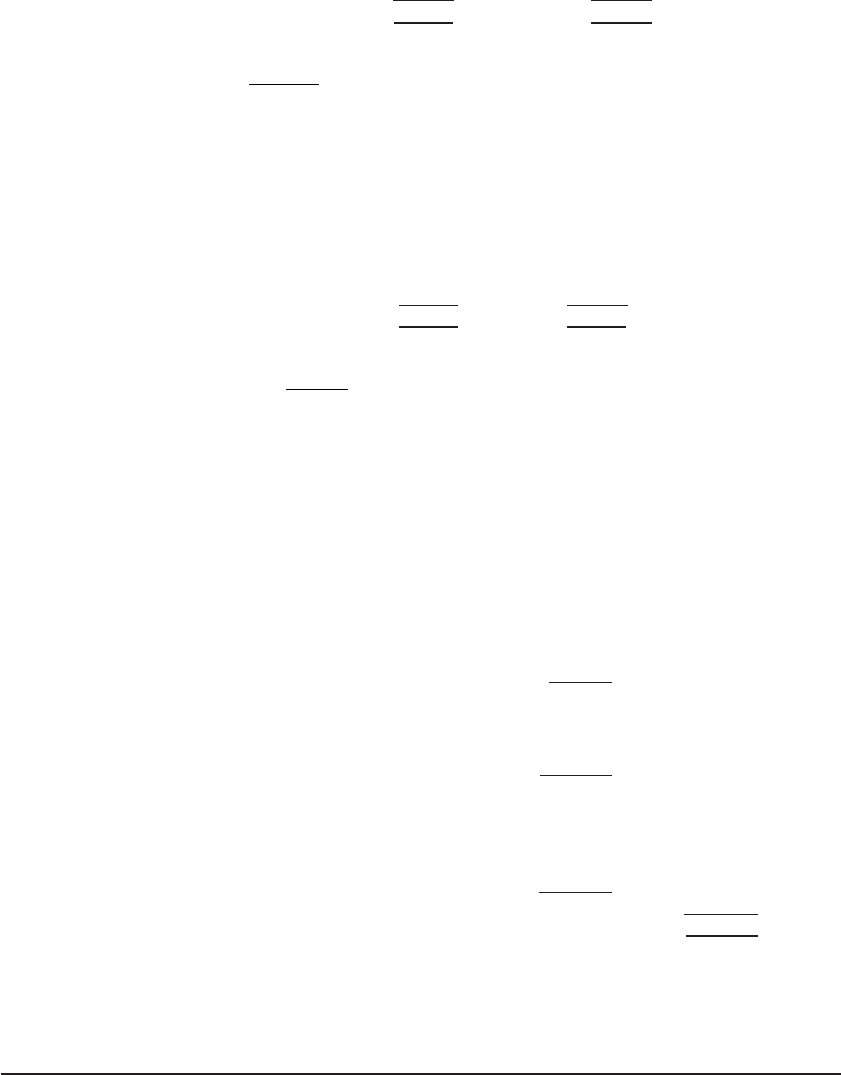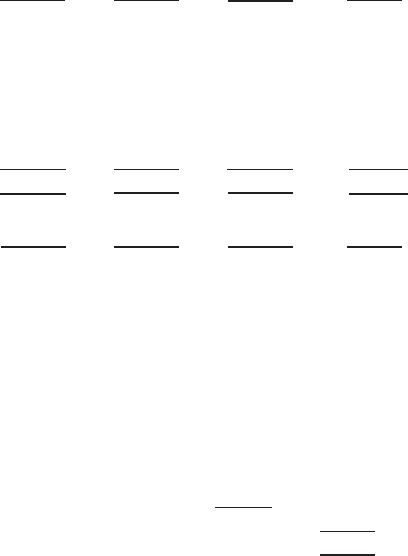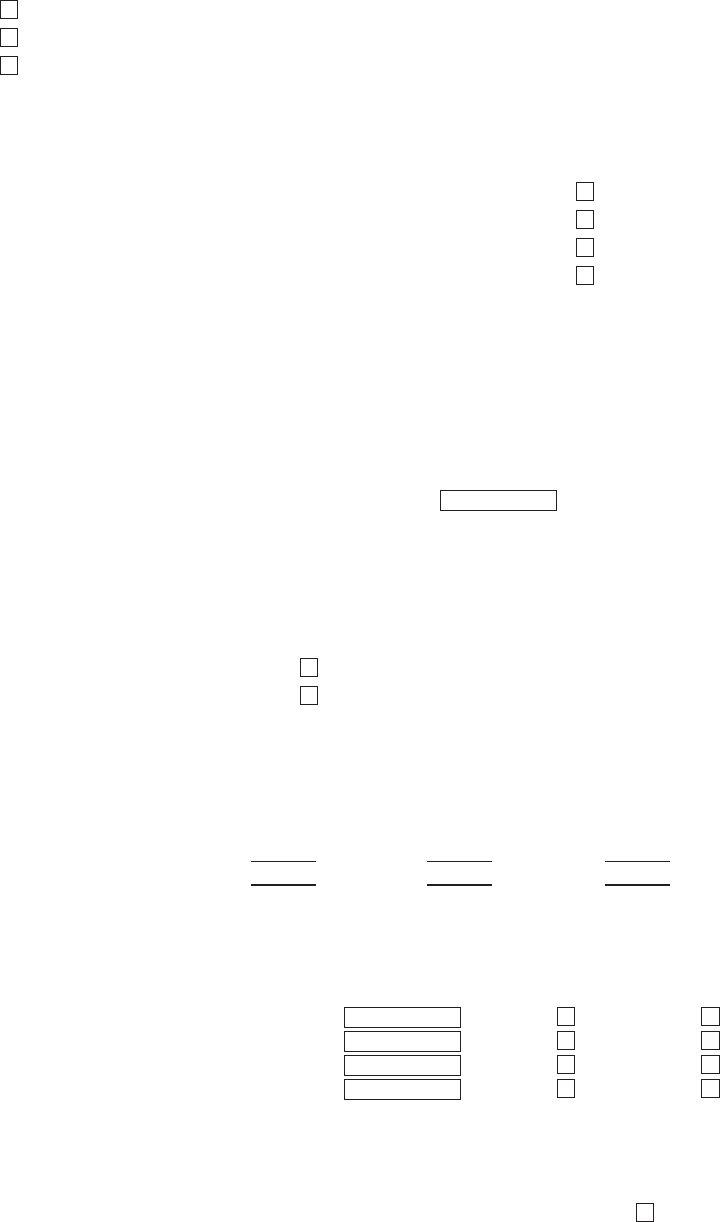CIMA CO1 Official Learning System - Fundamentals of Management Accounting
Подождите немного. Документ загружается.


STUDY MATERIAL C1
330
FINANCIAL PLANNING AND CONTROL
Production overhead
Production, units £
Quarter 2 13,000 109,000
Quarter 1 10,000 88,000
Change 3,000 21,000
Variable cost per unit
£
£ per unit
Fixed cost
21000
3000
7
,
,
£££ £109 000 7 13000 18 000,( ,),
Selling and distribution overhead
Note that the example data says that selling and distribution overhead is related to sales volume.
Sales, units £
Quarter 2 14,000 36,200
Quarter 1 9,000 29,700
5,000 6,500
Variable cost per unit sold
£
£ per unit
Fixe
6 500
5 000
130
,
,
.
dd cost £ £ £36 200 130 14 000 18000,(. ,),
We can now prepare a statement of the budget cost allowances for quarter 3.
Quarter 3
Budget cost allowance
££
Direct material (15,000 units £13) 195,000
Production labour:
1
Fixed 49,000
Variable up to 14,000 units (14,000 £2.50) 35,000
Variable above 14,000 units (1,000 £3.75) 3,750
87,750
Production overhead:
Fixed 18,000
Variable (15,000 £7) 105,000
123,000
Administration overhead: fi xed 26,000
Selling and distribution overhead:
Fixed 18,000
Variable (14,500 £1.30)
2
18,850
36,850
Total budget cost allowance 468,600
Note 1: The unit variable cost for production labour increases by 50 per cent for production over 14,000
units.
Note 2: The fl exible budget allowance for selling and distribution overhead must be based on the sales
volume of 14,500 units.

331
FUNDAMENTALS OF MANAGEMENT ACCOUNTING
FINANCIAL PLANNING AND CONTROL
11.10.6 Extrapolating outside the relevant range
In the preceding example, you were told that the cost structures would remain unaltered
despite the increase in activity. In practice, if you need to do a similar extrapolation outside
the range for which you have available data, you should always state the assumption that
the observed behaviour patterns will still be applicable.
11.10.7 Example: producing a flexible budget
control statement
G Limited produces and sells a single product. The budget for the latest period is as
follows.
£
Sales revenue (12,600 units) 277,200
Variable costs
Direct material 75,600
Direct labour 50,400
Production overhead 12,600
Fixed costs
Production overhead 13,450
Other overhead 10,220
162,270
Budget profi t 114,930
The actual results for the period were as follows.
£
Sales revenue (13,200 units) 303,600
Variable costs
Direct material 78,350
Direct labour 51,700
Production overhead 14,160
Fixed costs
Production overhead 13,710
Other overhead 10,160
168,080
Actual profi t 135,520
Required
Prepare a fl exible budget control statement and comment on the results.

STUDY MATERIAL C1
332
FINANCIAL PLANNING AND CONTROL
Solution
The budgeted sales revenue and the budget cost allo
wances for the variable costs are
increased by a factor of 13,200/12,600 to derive the fl exed budget for the actual activ-
ity achieved during the period. The budget cost allowance for the fi xed costs remains
unaltered.
Flexible budget control statement for the latest period
Original
budget
Flexed
budget
Actual
results Variance
Activity (units) 12,600 13,200 13,200
£ £ £ £
Sales revenue 277,200 290,400 303,600 13,200
Variable costs
Direct material 75,600 79,200 78,350 850
Direct labour 50,400 52,800 51,700 1,100
Production overhead 12,600 13,200 14,160 (960)
Fixed costs
Production overhead 13,450 13,450 13,710 (260)
Other overhead 10,220 10,220 10,160 60
162,270 168,870 168,080 790
Profi t 114,930 121,530 135,520 13,990
Note: variances in brackets are adverse
Comments
1. The total budget variance can be analysed as follows.
££
Sales volume variance* (£121,530 £114,930) 6,600
Sales price variance 13,200
Expenditure variance 790
13,990
Total budget variance (£135,520 £114,930) 20,590
*You can calculate the sales volume variance separately as a check on the budget fi gures: increase in
sales volume above budget standard contribution per unit (13,200 12,600) £((277,200
75,600 50,400 12,600)/12,600) 600 units £11 standard contribution £6,600 favourable
2. The favourable sales price variance indicates that a higher selling price than standard
was charged for the units sold. Despite the higher price the sales volume achieved was
higher than budgeted.
3. Expenditure on direct material, direct labour and other overhead costs was lower than
the budget cost allowance for the activity level achieved. It is not possible to tell from
the data provided whether the savings were achieved as a result of a lower price or a
lower usage of resources.
4. Expenditure on production overhead costs, both fi xed and variable, was higher than the
budget cost allowance for the activity level achieved.

333
FUNDAMENTALS OF MANAGEMENT ACCOUNTING
FINANCIAL PLANNING AND CONTROL
11.11 Using budgets as a basis for rewards
Budgets may be used as a basis for reward strategies for managers. In this situation, the
budget acts as a target for achievement and the budget holder’s success in meeting the
budget might be rewarded by the payment of a bonus.
11.11.1 Example
The maintenance manager has a budget cost allowance each period based on the actual
number of maintenance hours worked in the period. He is paid a bonus of 10% of any
savings he achieves against the fl exible budget cost allowance.
Budgeted fi xed maintenance costs are £17,800 per period and the budgeted variable
maintenance cost allowance is £14 per maintenance hour worked.
The number of maintenance hours worked in the latest period was 120 and the actual
total maintenance cost incurred was £17,600.
Requirement
Calculate the amount of any bonus payable to the manager.
Solution
Flexible budget cost allowance £17,800
(£14
120 hours) £19,480
Actual maintenance cost incurred £17,600
Savings achieved against the fl exible budget cost allowance £1,880
Bonus payable 10% £1,880 £188
11.11.2 Factors to consider in the design of budget
reward schemes
The potential to earn a bonus by the achievement of a budget target can create a powerful
incentive for budget holders. However, a number of factors should be considered in the
design of reward strategies.
●
A fl exible budget system should be used where appropriate so that the budget holder’s
performance is monitored against a realistic revenue and expenditure target for the actual
level of activity achieved.
●
Managers who are responsible for setting their own budgets in a participative budget-
ing system might set easy targets for themselves and build in budgetary slack in order to
improve their chances of earning a bonus. If the targets are not realistic as a result of this
budget padding then the budget will not be useful as a planning or control document.
●
Managers who are aiming to achieve a bonus based on their short-term budget perform-
ance might be tempted to cut back on expenditure which is necessary for the longer-
term strategy of the organisation, for example, training and development expenditure,
that is, the budget reward system might encourage short termism.
●
Managers might become demotivated if they fail to achieve their budget targets, and
thus do not earn a bonus, due to factors which are outside their control. A manager
should not be monitored against any budget target over which they are not able to
exercise control.
STUDY MATERIAL C1
334
FINANCIAL PLANNING AND CONTROL
Therefore a reward system based on the achievement of budget targets should be
designed and operated with due regard for the possible impact on managers ’ behaviour.
11.12 Summary
Having read this chapter, the main points that you should understand are as follows.
1. A budget is a quantifi ed plan of action relating to a given period of time. An organisa-
tion’s annual budget is set within the framework of the long-term strategic plans.
2. The budget committee coordinates the preparation of budgets and issues the budget
manual which provides information to those involved in the planning and control
process.
3. The principal (key) budget factor is the factor which limits the activities of the organ-
isation. The budget for the principal factor should be prepared fi rst.
4. The master budget is the summary of all the functional budgets, usually including a
budgeted income statement, balance sheet and cash fl ow statement.
5. Cash budgets allow for feedforward control by forewarning managers of the cash effect
of all their planning decisions.
6. Rolling or continuous budgets are continuously updated by adding a further period
when the earliest period has expired.
7. Incremental budgeting involves using the prior period’s budget or actual results as a
basis for the next year’s budget. Zero-based budgeting begins each year’s budget from
scratch.
8 . A fi xed budget is prepared for a single activity level. A fl exible budget is more useful
for control because it recognises cost and revenue behaviour patterns and the budget
cost allowance for each cost and revenue is designed to change as the volume of activity
changes.
9. Budgets may be used as a basis for reward strategies for managers.

335
Question 1 Multiple choice
1.1 When preparing a production budget, the quantity to be produced equals:
(A) sales quantity opening inventory closing inventory.
(B) sales quantity opening inventory closing inventory.
(C) sales quantity opening inventory closing inventory.
(D) sales quantity opening inventory closing inventory.
1.2 A job requires 2,400 actual labour hours for completion and it is anticipated that
there will be 20 per cent idle time. If the wage rate is £10 per hour, what is the
budgeted labour cost for the job?
(A) £19,200
(B) £24,000
(C) £28,800
(D) £30,000.
1.3 The term ‘ budget slack ’ refers to:
(A) the extended lead time between the preparation of the functional budgets and
the master budget.
(B) the difference between the budgeted output and the breakeven output.
(C) the additional capacity available which can be budgeted for.
(D) the deliberate overestimation of costs and underestimation of revenues in a budget.
1.4 Of the four costs shown below, which would not be included in the cash budget of
an insurance fi rm?
(A) depreciation of non-current assets
(B) commission paid to agents
(C) offi ce salaries
(D) capital cost of a new computer.
1.5 The following details have been extracted from the receivables collection records of
C Limited:
Invoice paid in the month after sale 60%
Invoice paid in the second month after sale 25%
Invoice paid in the third month after sale 12%
Bad debts 3%
Invoices are issued on the last day of each month.
Revision Questions
11

FINANCIAL PLANNING AND CONTROL
REVISION QUESTIONS C1
336
Customers paying in the month after sale are entitled to deduct a 2 per cent
settlement discount.
Credit sales values for June to September are budgeted as follows:
June July August September
£35,000 £40,000 £60,000 £45,000
The amount budgeted to be received from credit sales in September is
(A) £47,280
(B) £47,680
(C) £48,850
(D) £49,480.
1.6 A fl exible budget is:
(A) a budget which, by recognising different cost behaviour patterns, is designed to
change as the volume of activity changes.
(B) a budget for a defi ned period of time which includes planned revenues,
expenses, assets, liabilities and cash fl ow.
(C) a budget which is prepared for a period of one year which is reviewed monthly,
whereby each time actual results are reported, a further forecast period is added
and the intermediate period forecasts are updated.
(D) a budget of semi-variable production costs only.
1.7 The following extract is taken from the production cost budget of S Limited:
Production (units) 2,000 3,000
Production cost (£) 11,100 12,900
The budget cost allowance for an activity level of 4,000 units is
(A) £7,200
(B) £14,700
(C) £17,200
(D) £22,200.
1.8 A master budget comprises:
(A) the budgeted income statement.
(B) the budgeted cash fl ow, budgeted income statement and budgeted balance sheet.
(C) the budgeted cash fl ow.
(D) the entire set of budgets prepared.
1.9 A recent budgetary control report shows the following information:
Fixed budget Flexible budget Actual results
£££
Total sales revenue 585,847 543,776 563,945
Total variable costs 440,106 418,482 425,072
Total contribution 145,741 125,294 138,873

FINANCIAL PLANNING AND CONTROL
337
FUNDAMENTALS OF MANAGEMENT ACCOUNTING
The sales volume contribution variance for the period was:
(A) £6,868 adverse
(B) £13,579 favourable
(C) £20,447 adverse
(D) £42,071 adverse
1.10 Budgeted sales of product Y next period are 8,690 units. Each unit of product Y
requires 8 kg of material Z. Budgeted inventories are as follows:
Product Y Material Z
units kg
Opening inventory 875 6,300
Closing inventory 920 6,180
The budgeted purchases of material Z, in kg, next period are:
(A) 8,615
(B) 69,280
(C) 69,760
(D) 69,880
Question 2 Short objective-test questions
2.1 Tick the correct box.
A participative budgeting system may also be described as a:
bottom-up budget
top-down budget
2.2 Which of the following items of information would be contained in the budget
manual? (Tick all that are correct.)
(a) An organisation chart.
(b) The timetable for budget preparation.
(c) The master budget.
(d) A list of account codes.
(e) Sample forms to be completed during the budgetary process.
2.3 Is the following statement true or false?
The principal budget factor is always the forecast sales volume.
Tr u e
False
2.4 Assuming that sales volume is the principal budget factor, place the following budgets
in the order that they would be prepared in the budgetary planning process.
Indicate the correct order by writing 1, 2, 3, etc. in the boxes provided.
Sales budget
Materials purchases budget
Materials inventory budget

FINANCIAL PLANNING AND CONTROL
REVISION QUESTIONS C1
338
Production budget
Finished goods inventory budget
Materials usage budget.
2.5 PR Ltd’s cash budget forewarns of a short-term surplus. Which of the following
would be appropriate actions to take in this situation? (Select all that are correct).
(a) Increase receivables and inventory to boost sales.
(b) Purchase new non-current assets.
(c) Repay long-term loans.
(d) Pay suppliers early to obtain a cash discount.
2.6 Each fi nished unit of product H contains 3 litres of liquid L. Ten per cent of the
input of liquid L is lost through evaporation in the production process. Budgeted
output of product H for June is 3,000 units. Budgeted inventories of liquid L are:
●
Opening inventory, 1 June 1,200 litres
●
Closing inventory, 30 June 900 litres
The required purchases of liquid L for June are litres.
2.7 Tick the correct box.
A system of budgeting whereby the budget is continuously updated by adding a
further accounting period when the earliest accounting period has expired, is
known as a system of:
rolling budgets
incremental budgets
2.8 The totals from KM Ltd’s budgetary control report for February are as follows;
Fixed budget Flexible budget Actual results
£££
Total sales revenue 124,310 135,490 134,580
Total variable costs 93,480 98,450 97,920
Total contribution 30,830 37,040 36,660
Complete the following table, ticking the box to indicate whether the variance is
adverse or favourable.
£ Adverse Favourable
Sales price variance
Sales volume contribution variance
Total expenditure variance
Total budget variance
2.9 Which of the following best describes the principle of reporting by exception?
Sending budget reports only to those exceptional managers who
are able to understand their content.

FINANCIAL PLANNING AND CONTROL
339
FUNDAMENTALS OF MANAGEMENT ACCOUNTING
Providing detailed reports only on those areas of the business that
are performing exceptionally well and providing only subsidiary
information about other areas of the business.
Providing detailed reports only on those areas of the business that
are not performing according to budget and providing only
subsidiary information about aspects that are in line with budget.
2.10 F Limited uses a fl exible budgeting system to control the costs incurred in its staff
canteen.
The budget cost allowance for consumable materials is fl exed according to the
average number of employees during the period.
Complete the following equation by inserting ‘ ’ , ‘ ’ o r ‘ ’ as appropriate in
the boxes:
Flexible budget budgeted fi x e d
(budgeted variable average no.)
cost allowance cost (cost per employee of employees)
for consumable
materials
2.11 The following extract is taken from the catering costs budget of a company that
provides training courses.
Number of delegates 120 170
Catering cost £1,470 £2,020
In a fl exible budget for 185 delegates, the budget cost allowance for catering costs
will be £
2.12 The distribution manager is paid a bonus of 5% of any savings he achieves against
a fl exible budget cost allowance for distribution costs each period.
The budget cost allowances for distribution costs for the previous two periods
were as follows.
Tonnes distributed Budget cost allowance
£
11,200 118,400
16,100 152,700
In the latest period, the number of tonnes distributed was 13,200 and the distri-
bution cost incurred was £130,900.
The bonus payable to the distribution manager for the period is £
Question 3 Functional budgets
An ice cream manufacturer is in the process of preparing budgets for the next few months,
and the following draft fi gures are available:
Sales forecast
June 6,000 cases
July 7,500 cases
August 8,500 cases
September 7,000 cases
October 6,500 cases
